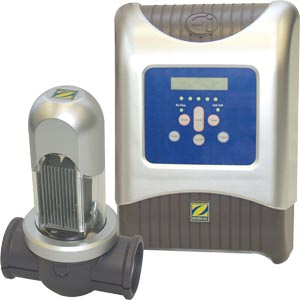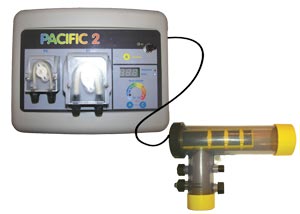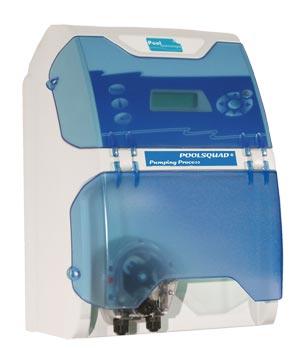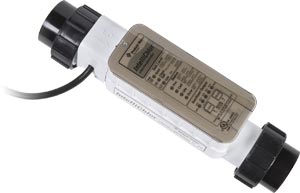|
|
by Sarah Guezbar |
Australia uses salt electrolysis to treat the water of family swimming pools since the 70s and it is still a reference. For the last fifteen years, the growth of the pool market has seen the arrival of other players, mainly European and American. These manufacturers now have a significant part of the market.
Salt electrolysis is a simple electrochemical reaction. When water turns slightly salty, usually around 3 to 7g of salt per litre, an electrolytic cell produces a powerful disinfectant: chlorine gas. The cell (or electrode) is composed of titanium plates polarized by DC power. When the salt water flows into the cell it produces disinfected and disinfecting water. Bacteria, chloramines and algae are destroyed, without residue or pollution. Bacteria are sources of infection, chloramines cause allergies and algae make water cloudy or green.
|
|
|
|
AstralPool Chloe Elite |
Intellichlore de Paintair |
The principle of salt electrolysis is a “natural circle”: subject to the effects of UV rays, the salt recomposes itself and is thus available for a new cycle.
Adding salt will however still be necessary to compensate for losses caused by splashes, leaks, or filter cleaning.
An electrolyser comprises two components: an electrolytic cell, also called an electrode, and an electronic control box.
The electrolysis cell
The electrolytic cell consists of titanium plates that are generally coated with ruthenium and iridium oxide.
The quality of titanium and its coating is crucial both for the performance of the sterilization and for the longevity of the electrolytic cell.
The electronic control box
The control module is the «smart» component of the electrolyser.
One can say that there are 2 families of electrolysers on the market: those with normal polarity and those with reverse polarity.
The former have the advantage of being economic, however, the cell requires cleaning with acid. Consequently, they are not recommended in the case of hard water.
The family of reverse polarity electrolysers has a wide range and includes two main technologies.
The first technology uses electronics with mechanical relays. This technology allows the reversal of polarity by switching the relays. This shift results in a transient peak in current in the cell, which reduces the life of the cell over time. Simple to use, this technology is most often found in lower price range devices. The reversal of polarity can be triggered on demand by the user himself or, more generally, automatically by electronics. In this case, the reversal of polarity is performed at a frequency that cannot be changed by the user; it is a predetermined frequency unique to each manufacturer.
The disadvantage of these electrolysers is that the reversal frequency is not necessarily suitable for all types of water. The more that the water is hard, the higher the frequency of reversal must be in order to avoid fouling the cell. However, the adjustment must be done carefully: reversing the polarity too frequently will result in a significant reduction of the cell’s life whereas not reversing the polarity enough can cause premature clogging, and would require tedious user intervention.
 |
 |
| Zodiac EL | Pacific Industrie |
The second technology uses an electronic microprocessor, which in particular allows the control of the current. This technology is more modern and has many advantages. Some of these electrolysers ensure self-cleaning by adjustable polarity reversal. One must set the reversal frequency depending on the hardness of water; in addition, this reversal of polarity is called ‘progressive’ because it occurs very slowly. This protects the cell by removing the risk of a spike in the current and therefore the risk of tearing the covered plates, unlike polarity reversal with mechanical relays. Some electrolysers even have a reversal memory. Thus, after a halt in the filtration, the electrolyser restarts the reversal from where it left off, before the filtration was stopped.
Regarding the efficacy of the disinfection, the second technology also helps to ensure a consistent production of chlorine.
All these characteristics are a guarantee of performance and a significantly extended life of the electrolytic cell. It also allows some manufacturers to offer extended warranties.
Worth knowing
Currently, an acceptable service life for a cell is about 4 to 5 seasons. When buying, customers are now very conscious of the cost of replacing the cell.
The product range has now expanded because in addition to the cells of the original manufacturers, alternative compatible cells have also appeared. For the latter case one must be vigilant of both the quality of the materials and the standard of assembly.
The product range is thus very large and not always easy to navigate. The simplest is still to choose from the blue chip stock on the market.
Finally, depending on budget and often on the technology used, the electrolyser will offer more or less features, features that will allow it to be set up according to the specifics of the installation and thus increase the user’s comfort.
 |
 |
| PoolSquad by Pool Technology | ProMATIC de Monarch Pool Systems |
Various options and features are available on the market :
- Self-cleaning of the cell by polarity reversal
- Adjustable self-cleaning depending on water hardness
- Automatic shutter mode to reduce the production of chlorine when the shutter is closed
- Boost function for super-chlorination in case of extremely bad weather or overcrowding
- Alarms : lack of salt, lack of water, temperature, insufficient filtration time...
- Automatic hibernate in winter and startup in spring.
- Electrolysis Test
- Event History...
Simple and effective, salt electrolysis has many advantages :
- Tranquillity : the pool is disinfected automatically
- Respect for the environment and safety : low energy consumption, no chemical disinfectant to handle, store or buy
- Comfort : clean, healthy, and clear water
- Health and well-being : salt water is therapeutic and does not irritate the eyes or dry the skin.














